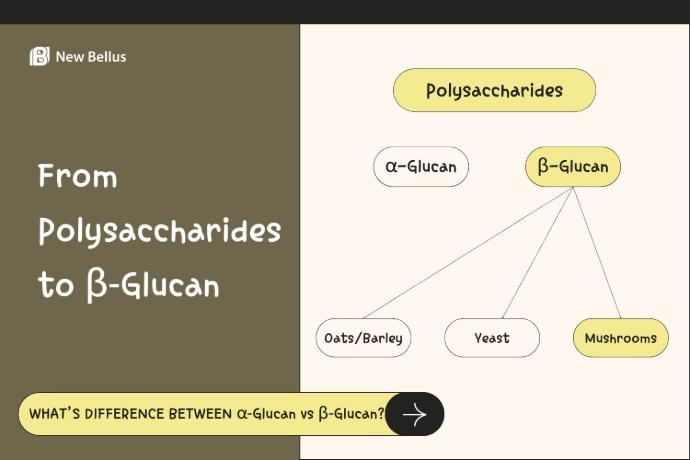
Key Takeaways
- Polysaccharides aren’t a single active: α and β differ in structure and biological pathways, leading to very different functional outcomes.
- α vs β: α‑glucans are digestible and primarily provide energy/nutrition; β‑glucans are non‑digestible and can activate immune and metabolism‑related mechanisms.
- The 3 main β‑glucan sources have different strengths: oats/barley for metabolic goals; yeast for immune support but with poor water solubility; mushrooms for immune support with high water solubility.
- 3 selection keys: polysaccharide source, functional claim, and product application.
- New Bellus solution: Mushroom‑derived β‑glucan with high water solubility (≥40%), containing L‑ergothioneine and compliant with EU requirements—friendly to multiple dosage forms and cross‑market applications.
From Polysaccharides to β‑Glucan: Why You Must Separate α from β
Polysaccharides are macromolecules composed of many monosaccharides, but different structural motifs lead to distinct biological pathways and functional value. The two major types are α‑glucans and β‑glucans. If R&D focuses only on “polysaccharide content” without checking structural form, nutrition supply and functional modulation can get mixed up, resulting in formulas that miss the intended claims.
α‑glucans are digested to monosaccharides and absorbed. Their role is mainly energy/nutrition supply and they are not directly linked to immune modulation. Common sources include grains/starch. Note that many “polysaccharide” extracts from solid cultivation or fruiting bodies may be α‑dominant, so a high labeled polysaccharide content does not automatically mean high functional value.
β‑glucans are not broken down by human
digestive enzymes. They can reach the intestine intact, interact with
gut‑associated lymphoid tissue, and bind to receptors on macrophages to
activate innate immunity. They also have use cases for lipid and glycemic
control. Common sources include oats/barley, yeast, and mushrooms. For R&D
teams, product performance and formulability hinge on three variables: source,
functional claim, and application form.

α‑Glucan vs β‑Glucan (R&D Lens)
|
||
|
Aspect
|
α-
Glucan
|
β-Glucan |
|
Digestible?
|
Yes—broken
down to monosaccharides and absorbed
|
No—can
reach the intestine intact
|
|
Primary
role
|
Nutrition
supply
|
Functional
modulation (constitution/metabolic health)
|
|
Common
sources
|
Grains,
starch, some fruiting‑body extracts
|
Oats/Barley,
Yeast, Mushrooms
|
|
R&D
focus
|
Raw‑material
purity, palatability
|
Source,
functionality, branching ratio, solubility
|
What Is β‑Glucan? Definition and Value
β‑glucan is a polymer of D‑glucose and is a soluble dietary fiber that is not hydrolyzed by human digestive enzymes. Because it reaches the intestine intact and interacts with immune cells, β‑glucan has application value in cardiovascular support, glycemic management, gut health, and immune support. Clinical and safety data suggest good tolerability as a food ingredient, suitable for multiple dosage forms.

Lower blood cholesterol

Modulate the
glycemic response

Maintain gut health

Support physiologic balance
The Three Main Sources of β‑Glucan: How Structure Links to Function and Application?
Although all are called β-glucan, different sources have distinct molecular structures and branching patterns, which in turn lead to specialization in functions and applications.
Comparison Table of β-Glucan from the Three Main Sources
|
Source |
Structural
features
|
Function
& application
|
Water
solubility
|
Development
potential
|
| Oats
/ Barley
|
Linear
chains (no branching) |
Forms
viscous gels; suitable for lipid/glycemic management and cardiovascular support
|
High |
Cereal
beverages, metabolic‑management formulas
|
|
Yeast |
Long
side chains
|
Immune
modulation, but lower solubility limits processing and formats
| Low |
Immune‑support
products, special uses
|
|
Mushrooms |
Short
side chains (good solubility) |
Immune
modulation + better solubility for wider uses
| High |
All‑ages
health, beverages/powders
|
3 Keys to Selecting Polysaccharides (R&D/Formulation View)
- Source: Determine whether it is α‑glucan or β‑glucan. α‑glucan mainly serves as nutrition supply and offers limited benefits for physiologic modulation; for functional aims, choose β‑glucan sources.
- Functional claim: For metabolic management, prioritize oat/barley β‑glucan; for immune support, consider yeast or mushroom β‑glucan.
- Application: Mushroom β‑glucan typically has short side chains and high water solubility, enabling broader applicability and more flexible dosage‑form development.
New Bellus Solution: Mushroom β‑Glucan with Strong R&D Value and Formulation Friendliness
Mushroom β‑glucan balances function and usability via short side chains plus high water solubility. Building on this foundation, New Bellus’s mushroom β‑glucan strengthens three R&D priorities:
- High water solubility: With specialized processing, water‑soluble β‑glucan content reaches ≥40%, enabling beverages, instant powders, tablets, capsules, and more—greater freedom to combine ingredients.
- Multiple actives: Naturally contains compounds such as L‑ergothioneine to support more differentiated functional combinations.
- Compliance for expansion: Meets EU inspection indicators to reduce barriers to cross‑market development and support international launches.
Use Science and Craft to Build Competitiveness
Returning “polysaccharides” to their structural essence prevents the mistake of judging by content alone: α is about nutrition supply, β is about functional modulation. In the β‑glucan space, source, molecular weight, and branching ratio are three inseparable decision axes. If your product needs to balance physiologic modulation × solubility × dosage‑form flexibility, New Bellus’s mushroom β‑glucan offers a reliable, scalable, and internationally compliant solution to help your formula reach the market faster and more robustly.
FAQ
Q1|Does “high polysaccharide content” mean it’s rich in β‑glucan?
Not necessarily. Many polysaccharide extracts from fruiting bodies or solid fermentation are α‑dominant. You need the α/β breakdown and validation data to evaluate functional value.
Q2|Is a smaller molecular weight always better?
No. Excessively large molecular weight can hinder absorption, but making it too small may sacrifice active structures. Target a range that balances activity and bioavailability, and verify with functional indicators.
Q3|If
yeast β‑glucan is strong for immunity, why is it used less broadly than
mushroom β‑glucan?
Yeast β‑glucan tends to have long side chains and immune activity but poor solubility, which limits mouthfeel and dosage‑form flexibility. Mushroom β‑glucan with short side chains and high solubility is more formulation‑friendly.
Q4|Without
branching, does oat β‑glucan still have value?
Yes. Oat/barley β‑glucan forms viscous gels in the gut and slows absorption, supporting lipid and glycemic control—ideal for metabolism‑oriented beverages and cereal formulas.
Q5|Which
dosage forms fit New Bellus’s mushroom β‑glucan?
Thanks to high solubility and stability: instant powders, beverages, tablets, capsules, etc. Its high solubility also suits functional drinks, sports supplements, nutritional beverages, and traditional tonics like chicken essence/birds‑nest products.